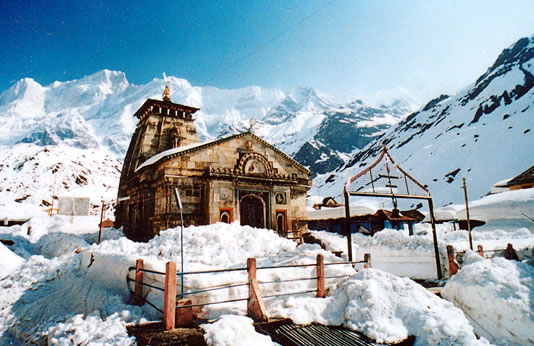New Delhi: Scientists claim that Kedarnath temple was under snow for almost 400 years and say that most of the people are unaware of this fact. According to scientists of Wadia Institute of Himalayan Geology, Dehradun, Kedarnath temple survived being buried under the snow for almost 4oo years and so they are not surprised that the shrine did not suffer much damage during the massive floods on June 15-16 in the region.
According to the scientists, the temple structure has several yellow lines, which were formed as the glacier slowing moved over the stones. Actually glaciers move very slowly and are not only made up of snow and ice but also have rocks and mud. The temple not only survived being under the snow for 400 years but also escaped any serious damage due to glacial movement even though its impact can be seen in the form of yellow lines on the stones used in constructing the Kedarnath shrine. Scientist say that even the inside of the temple shows signs of glacial movement and the stones are more polished.
They point out that the period between 1300-1900 AD is known as Little Ice Age when a large portion of the earth was covered by the snow. It is believed that during the period Kedarnath temple and neighbouring are was covered by snow and became a part of glaciers. Although there is no documentary evidence regarding the age of Kedarnath temple and by whom it was constructed, but there are several myths about its construction.
Some says Raja Bhoj of Malwa, who ruled between 1076 to 1099 AD, built the temple while another theory is that the temple was built in the eight century by Adi Shankracharya. There is also a legend that Pandavas built a temple behind the Kedarnath shrine in the Hindu Dwapar era. But the temple could not survive the vagaries of times.According to the Garhwal Vikas Nigam the temple was built by Adi Shankaracharya in the eight century and so existed when the Little Ice Age of 1300-1900 AD came.
Wadia Institute of Geology scientists conducted Lichenometric dating of Kedarnath temple and the nearby areas. Lichenometric dating is a technique to find out the age of stones. According to the Lichenometric dating, glacial formation in the area started in the mid of 14th century and continued till 1748.
So it is clear when the temple was being constructed, the technicians not only kept in mind the terrain but also the formation of snow and glaciers and ensured that the structure was strong enough not only to withstand natural disasters and the passage of time. Actually, the entire area of Kedarnath is a part of Chorabari glacier. Kedarnath temple is surrounded by mountains from three sides. On one side is the 22,000 feet high Kedarnth while Kharchkund, which is 21,600 feet high, is on the other side and on the third side is the 22,700 feet Bharatkund. According to the legend the area also has five rivers Mandakini, Madhuganga, Chhirganga, Saraswati and Swarndari but some of them are mythical.
But Mandakini rules the Kedarnath area and there is heavy snow in winter and plenty of water during the rainy season. So the believers kept in mind that in Hindu religion Shiv, to whom Kedarnath is dedicated, is a not only a saviour but also a destroyer. So the entire temple complex and the area was built in such a way that the shrine would be able to survive natural disasters. The temple is 85 feet high, 187 feet in length and 80 wide. Its walls are 12 feet thick and built from extremely strong stones and stands on a six-foot high platform.






























